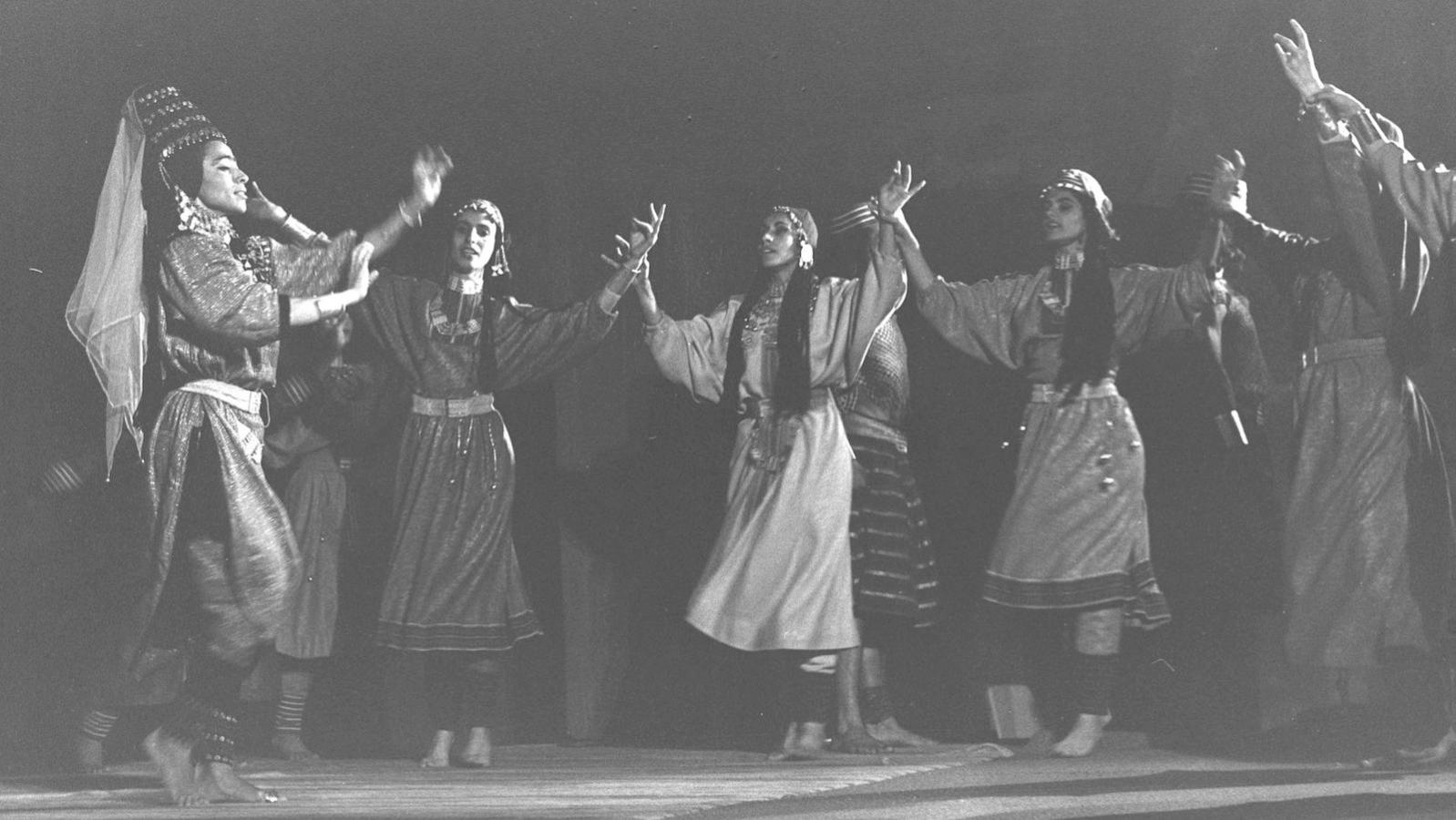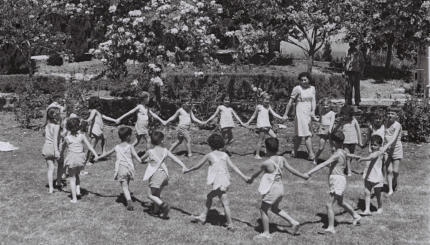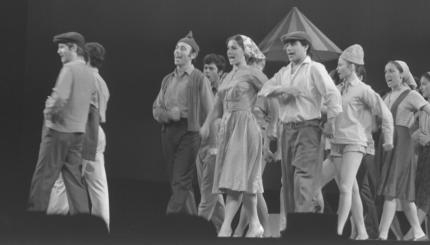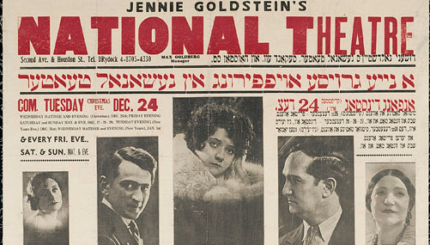Nobody, even she herself, can be sure what age she really is. This is not because of the usual vanity of grand ladies of the dance, who think they can cheat time but succeed only in making the life of dance historians difficult. The true date of birth for perhaps the most important Israeli choreographer of the last fifty years is unknown.
Sara Levi-Tanai was born in Jerusalem sometime before the First World War to parents who had come from Yemen in the 1880s. They moved to Jerusalem during the era of the Ottoman reign and under the Turks there were no official birth certificates. When Sara was about four years old, her mother and siblings died in an epidemic, probably of cholera. Her father, who had severe alcohol problems, abandoned his daughter to her fate. She was raised in an orphanage in the Galilee by teachers from Europe.
Encounter with Yemen
In 1949, one year after the foundation of the independent State of Israel, she met with her true destiny. She encountered a group of youngsters who had just arrived from Yemen to settle in Israel and began teaching them Israeli songs and dances. Her students were exceptionally gifted boys and girls and from them she learned many aspects of the Yemenite-Jewish traditions. As the ancient Hebrew adage has it, “I learned from all my teachers, but most of all from my pupils.”
They would sing and dance for her in their traditional and exuberant manner, so different from the European songs and dances she had been taught in the orphanage. Sara began experimenting with the traditional Yemenite dance steps, rhythms, and melodies that were her students’ expertise.

Help us keep Jewish knowledge accessible to millions of people around the world.
Your donation to My Jewish Learning fuels endless journeys of Jewish discovery. With your help, My Jewish Learning can continue to provide nonstop opportunities for learning, connection and growth.
She particularly noted a stepping pattern they referred to as the Da’asa (swaying the torso and hips gently forward and back, progressing counter-clockwise). For Sara Levi-Tanai, the Da’asa became symbolic of walking in the desert, of caravans, of the wide empty spaces that she so loves. She has utilized this and other folkloric traditional patterns in many variations in her choreography.
Only when Sara became a student at the Levinsky Teachers Seminar in Tel Aviv in her late teens, did she go to visit the Yemenite quarter, Kerem Hateymanim. There she heard and saw Yemenite song and dancing and encountered the rich artistic heritage of her ancestors. As she has often said, “I knew Dostoevsky and Shakespeare long before reading the poems of the great Yemenite poet Shalom Shabazi . . .
From Dostoevsky to Shabazi
In order to fully understand her work and its relation to ancient Yemenite folk traditions, it is necessary to deal with several important points, including the contrast in her own background between her Western and her Yemenite ancestry; the difference between a constructed Israeli folk dance and ethnic dance traditions; the Yemenite-Jewish dance tradition and how she changed that in her work.
Firstly, one should consider the contrast between her education grounded in classic European and English texts, as well as Hebrew poetry and the Bible, with her own Yemenite background. Yemenite Jews are perhaps the single Jewish ethnic group to possess a folkloric tradition comprising all aspects of art with a distinct style of music, dance, poetry, and visual ornamentation (as seen in jewelry and costume).
To what extent this is similar to non-Jewish Yemenite folk culture is until now a moot point because of geo-political reasons. It has been nearly impossible for Israeli researchers to visit Yemen. If one may make a comparison with Jewish traditions in Eastern Europe to Yemenite, perhaps the answer is that just as hasidic or klezmer music and dance is a variation of Slavic folk art, used at distinctive Jewish events, so is Jewish-Yemenite art, though this has yet to be proven.
Be that as it may, Sara Levi-Tanai was concerned with a total experience and her dancers, especially in the beginning, sang and drummed as well as danced, thereby affecting their audiences in very strong ways.
Folk Dance in Israel
In Israel there are many kinds of folk dance. One must distinguish between the ethnic dance brought to Israel by different Jewish communities, the ethnic dance of non-Jewish groups living in the area (such as the indigenous Arabs, Druze, and Bedouin), and the Israeli folk dance created from the 1930s to today.
Israeli folk dance–very much alive today and known all over the world–is an “invented” folk dance style developed by professional choreographers, mainly those who came to live in Israel in the 1930s. Many of the folk dances in favor today were created for pageants and festivities, mainly in the rural, collective settlements (kibbutzim and moshavim) in the 1940s. Those that survived as social folk dances did so by a process of natural selection through their use in schools, festivals, special festivities, and other vehicles. Those that were danced and liked by dancers and the dancing public became true folk dances, while others simply disappeared.
When Sara Levi-Tanai worked as a kindergarten teacher at Kibbutz Ramat Hakovesh during World War II, she composed songs and dances such as her winning El Ginat Egoz (“to the walnut grove”). This has become a classic of both Israeli folk song and dance.
Modern Dance, Ancient Movements
Her work was often and, to my mind, quite erroneously, labeled as folkloric. Her choreography, as it developed for her company, is modern, contemporary dance, using ancient movement and rhythmic elements.
Such great folk dance choreographers as Igor Moiseyev or Amalia Hernandez “domesticated” folk dance to fit the modern stage. Mainly, they solved the spatial problem of many folk dances performed in a circle, thus excluding spectators from the central arena. Unlike them, Sara Levi-Tanai has “dissolved” ancient folk dance traditions and built her own original choreographic structures from the basic folkloric components.
Sara Levi-Tanai learned the traditional Yemenite-Jewish dance traditions to change and contemporize them. In Yemenite-Jewish dance tradition there is a clear distinction between the dances of males, who usually dance in solo, duets or trios, and the group dances of women. The men improvise freely, entertaining the wedding guests and of course the bride and groom to songs from the liturgical tradition sung in Hebrew. Women dance separately from men to songs they improvise, often in witty verses sung in a Jewish-Arabic dialect, created on the spot by one of the women.
Sara Levi-Tanai, from the very beginning of her work with the Inbal Dance Theatre, abolished the tradition of separate dancing of men and women. On stage there was always mixing of the sexes. Though there was an improvisational, spontaneous quality to the dances, she constructed her choreographic compositions according to the demands of her dramatic, literary, or emotional ideas. The traditional Yemenite-Jewish dances were not narratives. She felt free to develop dramatic and literary premises, perhaps because of her Ashkenazic literary education.
Achievements and Legacy
By 1952, Sara Levi-Tanai had a group performing her own dances. That year Jerome Robbins came to Israel to report on the dance scene for the Norman Fund’s American Fund for Israeli Institutes, and was introduced to Sara and her work. Robbins found Sara Levi-Tanai’s choreography brilliant, original, and unique, and called the mainly vertical dance movement of the Yemenite men ”Yemenite Gothic.”
He was also fascinated with the softly bent knee of the Yemenite dancer and regarded it as “the perfect demi-plié.” His report recommended supporting the fledgling company, called Inbal Dance Theatre, and bringing technique teachers from abroad to instruct its dancers, whom he found fascinating but untrained. He specifically recommended that Anna Sokolow be sent to teach modern technique and stagecraft, which she did for many extended periods in the 1950s and early 1960s. Robbins also suggested to the impresario Sol Hurok that Inbal be brought on tour to America.
In 1956-57 Hurok sponsored Inbal on its first tour of the United States and Europe. The critics and the audiences there and in Western Europe were enthusiastic, captivated by the bearded men and the lithe women who accompanied their dance with singing and the playing of drums.
Audiences saw Sara’s inspiration from the bible realized on stage along with images effectively showing the landscape of Israel, the desert as well as poetry, especially that of the 17th century Yemenite poet Shalom Shabazi. Sara forged out of the Yemenite-Jewish ethnic materials a unique modern dance style all her own.
Some of her major works are: Song of Deborah (1955); Yemenite Wedding (1956), The Story of Ruth (1961 and revived in 1996), Carry us to the Desert (1964), Jacob in Haran (1973), and Song of Songs (1982, revived in 1996).
Like many great artists, Levi-Tanai tenaciously resisted any attempt to recreate or restage her choreography. Only in 1996, when she had become director emeritus of Inbal, were dances successfully re-staged by veteran Inbal dancers including Lea and Ilana Cohen, who has been Inbal’s artistic director since 1997.
Reprinted with permission from the Jewish Folklore and Ethnology Review.



